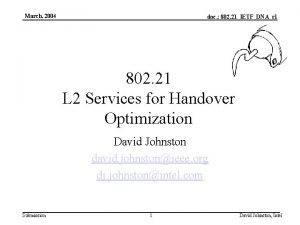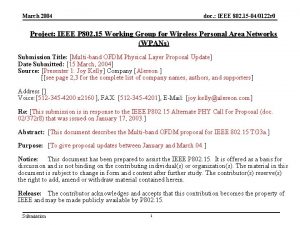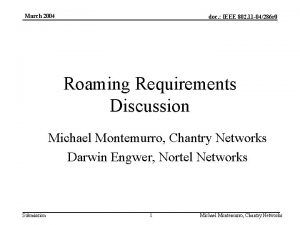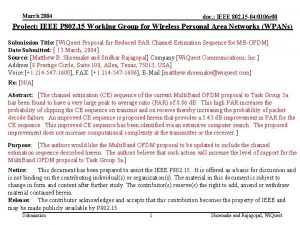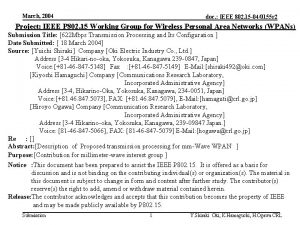March 2004 doc IEEE 802 11 040170 r









- Slides: 9

March 2004 doc. : IEEE 802. 11 -04/0170 r 0 TGn Simulation Methodology Ad Hoc Overview Jeff Gilbert Atheros Communications Submission 1 J. Gilbert, Atheros Communications

March 2004 doc. : IEEE 802. 11 -04/0170 r 0 History – Simulations methodology ad hoc has been formed based on the belief by the majority of the TGn body that we need a unified way of modeling the PHY error rate in MAC / System simulations – Issue has been raised: • J. Gilbert (Atheros) - 11 -03 -0888 – Albuquerque • Large consensus in 1/6/04 FRCC telecon. of need • H. Bonneville and B. Jechoux (Mitsubishi) 11 -04 -0120 Vancouver – 1/15/04 TGn straw polls and votes Submission 2 J. Gilbert, Atheros Communications

March 2004 doc. : IEEE 802. 11 -04/0170 r 0 Charter – Simulation Methodology Ad hoc was discussed and approved in the TGn session on 1/15/04 and announced at the 1/16/04 closing plenary – Bi-weekly conference calls to be held – Ad Hoc chartered through March Plenary (w/ extension by TGn vote if nec. ) to define a PHY-MAC interface to be used in MAC simulations generating results reported in the CC matrix – Following the sub-committee's completion there will be a TGn vote to determine whether the methodology will be mandatory or optional Submission 3 J. Gilbert, Atheros Communications

March 2004 doc. : IEEE 802. 11 -04/0170 r 0 PHY Abstraction problem – PHY / MAC interface can dramatically impact overall results: • Time varying channel creates time varying PER • Affects overall delay, jitter, and goodput – Challenges • Properly model PHY characteristics in MAC sims • Keep flexibility to readily adapt to different proposals’ PHYs • Keep simulation effort reasonable Submission 4 J. Gilbert, Atheros Communications

March 2004 doc. : IEEE 802. 11 -04/0170 r 0 Goals – Goals of a common phy / MAC interface: • Allow fair comparison of MAC / system results • Facilitate verification / cross-checking of results – Intermediate results to simplify process • Possible other goals to be discussed: – Ability to merge MAC and PHY from different proposers – Ability to simulate MAC-only modifications with known PHY Submission 5 J. Gilbert, Atheros Communications

March 2004 doc. : IEEE 802. 11 -04/0170 r 0 Risks of not specifying Abstraction – Without common PHY/MAC interface, results could depend more on simulation methodology than proposal – Possible interpretations: • • Idealized PHY Distance -> fixed PER (based on theoretical values) Distance -> mean SNR (w, w/o interference) -> PER Distance -> fading SNR -> capacity formula -> PER Fully accurate PHY model w/rate adaptation -> PER lookup Approximate PHY based on SNR profile in MAC simulation Full PHY simulation per packet in MAC simulation – Standardizing the abstraction could save significant time during the proposal evaluation selection process Submission 6 J. Gilbert, Atheros Communications

March 2004 doc. : IEEE 802. 11 -04/0170 r 0 Some PHY Abstraction-Related Work – Black-box PHY methods • Use full accuracy of PHY sims w/ rate adapt encapsulated in tables • Tight coupling of channel & PHY models, looser coupling w/ MAC • Example from Mitsubishi /Atheros (11 -04/0 xxx) – PHY integrated into MAC methods • Parametric version of PHY incorporated in system simulations • Looser coupling of channel & PHY models, tighter coupling w/ MAC • Example from Intel (11 -03/0863) – “Channel Capacity to determine PERs” method • Markov model for channel capacity mapped to PERs • Channel capacity links Markov channel model and per-rate PERs • Example from ST Microelectronics (11 -04/0064) – Challenges: • Accurately model channel variation, MAC interactions, arbitrary PHYs Submission 7 J. Gilbert, Atheros Communications

March 2004 doc. : IEEE 802. 11 -04/0170 r 0 Goals of the Ad Hoc Committee – Determine a methodology that the TGn body will choose to adopt to allow fair comparisons – If we cannot arrive at a single methodology, refine 2 -3 to be selected from at the March 2004 session – All members of ad hoc should provide positive feedback to improve the various approaches and focus on consensus Submission 8 J. Gilbert, Atheros Communications

March 2004 doc. : IEEE 802. 11 -04/0170 r 0 Process of the Ad Hoc Committee – It is critical that we move quickly in order to have conclusions to present at the March 2004 session – There will be 3 calls prior to the March 2004 session: • Feb 05, 2004 08: 00 Pacific Time • Feb 19, 2004 00: 00 Pacific Time • Mar 04, 2004 16: 00 Pacific Time – Proposed Agenda: • During the 1 st call, the goal of the group and overview of different approaches will be discussed • During the 2 nd call, specific proposed methodologies (posted on server w/ email to reflector by Feb 16) will be discussed • During the 3 rd call, proposal(s) to be presented to the TGn body (posted w/email by Mar 1) will be selected and refined Submission 9 J. Gilbert, Atheros Communications











